
 |
Tutorial 09 |
Advanced topics |
|
User defined constants and adjusting graph scales |
|
 |
back to advanced graphing |
on to statistics |
 |
n this tutorial we will discuss two topics that fall under the heading of useful but not often used. The first topic discusses creating user-defined constants. The second topic discusses the need to occasionally adjusting the graph's scale.
As you know the built-in constant PI( ) is used when you wish to express the value of p. Excel also allows the user to define his or her own constants. For example, you will notice that many of the Biology formulas you will encounter this year make use of many constants such as g, the acceleration due to gravity. At our latitude in SMCM, SC, we experience an acceleration due to earth's gravity which is g = 9.80 m/s2.
You will find that you will use the value for g throughout the year. When using Excel, rather than typing 9.80 each time you wish to express the acceleration due to earth's gravity, you can define the constant with a descriptive name or symbol, say in this case, 'g', to equal 9.80. Then simply use your defined constant, g, in your formulas.
Let us work a non-Biology example to see how to define our own constants. Again, there are several ways to define constants, but this is one method that I think will be most helpful.
Say, for example that you are the owner of a produce stand and you wish to
use Excel to calculate the amount each customer owes. This amount is dependent
on the cost of each produce item and also the quantity purchased. Say, you
sell apples for $0.25, oranges for $0.45, and pears for $0.65. These costs
change on a daily basis, so it will be helpful to be able to quickly and
easily change the costs of the produce without having to change any of your
total cost formulas. 
Your first step is to set up a data table like the one to the right. Notice that the words "Apples", "Oranges" and "Pears" appear next to their individual purchase cost. While this is not imperative, it is helpful to organize your table this way.
Also notice the Name Box is encircled in the screen shot to the right. This indicates that cell B3 has been clicked on. You should also be aware that the formula bar indicates that the value for cell B3 is 0.25. There is nothing new here.
Now we wish to define three constants that represent the cost of each produce item. Let us define our first constant as "apple" to represent the cost of an apple. To do this, follow the steps below:

Note that the naming of constants is not case sensitive, i.e., Excel does not distinguish between upper and lower case characters. See the Excel help menu for other guidelines regarding naming your constants.

 You
can perform a short test to see if you successfully named your
constant. To do so, click into an empty cell, type "=apple" and
hit the <ENTER> key. The value 0.25 should then appear
in that cell!
You
can perform a short test to see if you successfully named your
constant. To do so, click into an empty cell, type "=apple" and
hit the <ENTER> key. The value 0.25 should then appear
in that cell!

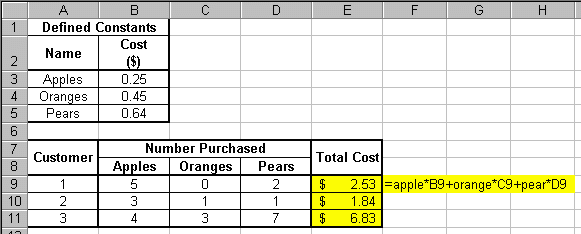
This may seem to be a lot of trouble, but it can be very helpful if your constants change values often. For instance, say the cost of pears drop to $0.50. To adjust your worksheet properly, all you have to do is change the value of the constant "pear". To do this, simply change the value of cell B5, which will automatically change the value of the pear constant, which in turn automatically changes the total cost values. There is no need to alter any of the formulas!
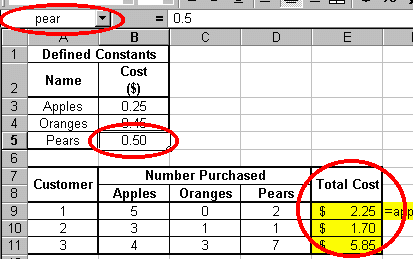
If you would like to delete a constant, the easiest way is to click Insert >> Name >> Define on the Menu Bar. Then select the appropriate constant and click the Delete button.
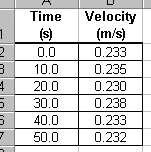 Often you will plot data
that is relatively constant. For instance, say you measure the velocity of
an air track glider on a level track. The velocity of the glider in this situation
should be constant as the data to the right shows.
Often you will plot data
that is relatively constant. For instance, say you measure the velocity of
an air track glider on a level track. The velocity of the glider in this situation
should be constant as the data to the right shows.
However, when Excel plots the data, the scale of the velocity axis is such that the data appears to be widely varying as shown below.
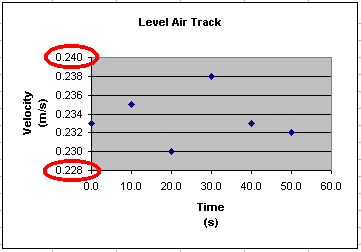
To make the graph display a more obviously linear trend, we need to expand the scale of the vertical (velocity) axis. To do so, simply double-click on the vertical axis and change the scale accordingly. The final result is shown below:
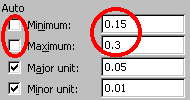
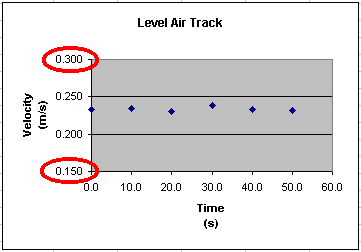
Note that both graphs plot the same data! The only difference in the graphs is their scale.
Note that the axis maximum and
minimum were entered manually as indicated by the red circles in the above
screen shot.
 |
back to advanced graphing |
on to statistics |
 |
Copyright © 2000, St. Mary's College of Maryland. All Rights Reserved.
Please send comments, problems or request for topics to
Walter I. Hatch
wihatch@smcm.edu
August 11, 2005